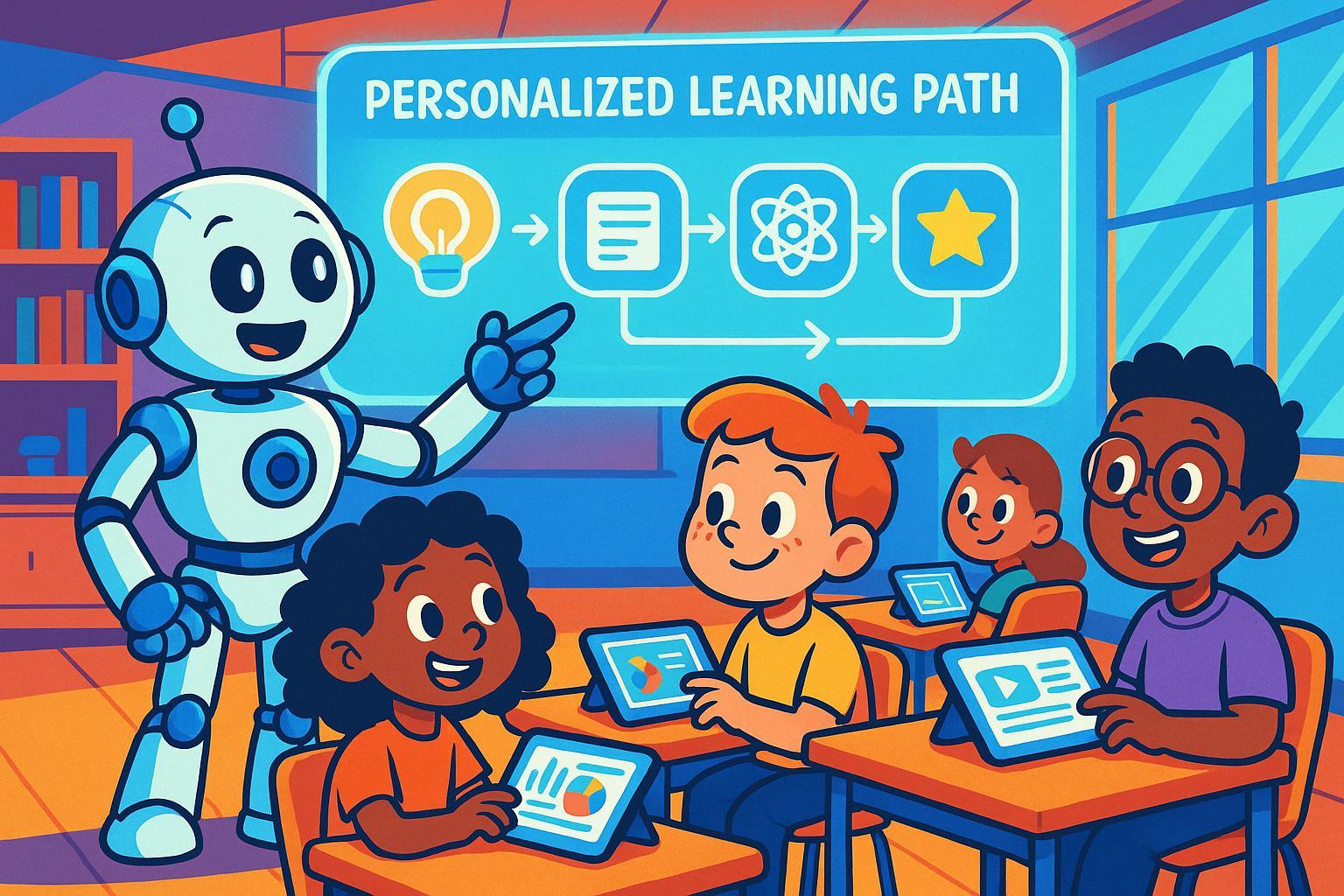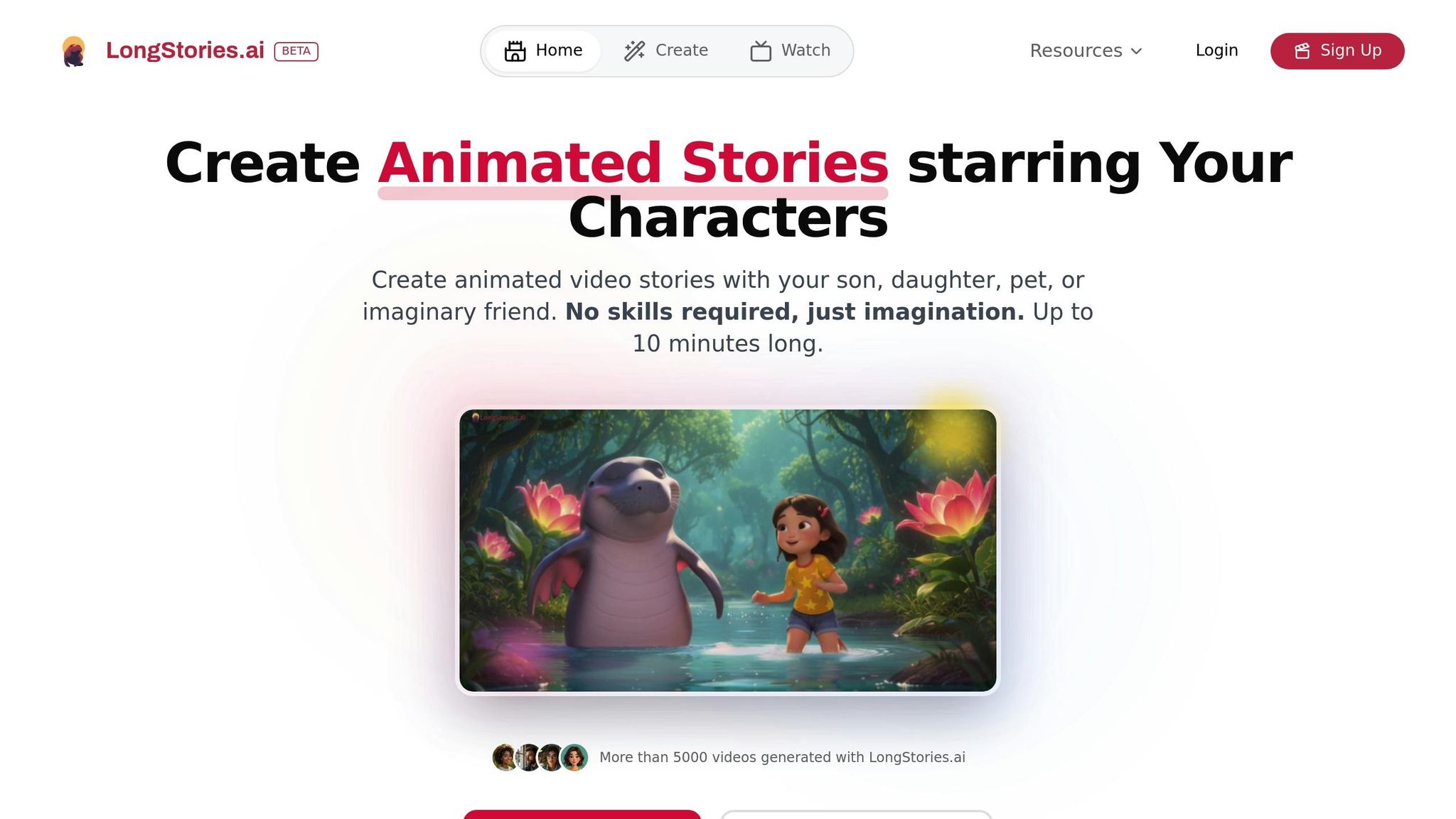
LongStories is constantly evolving as it finds its product-market fit. Features, pricing, and offerings are continuously being refined and updated. The information in this blog post reflects our understanding at the time of writing. Please always check LongStories.ai for the latest information about our products, features, and pricing, or contact us directly for the most current details.
Dynamic Content Sequencing in AI Learning Tools
AI is reshaping education with dynamic content sequencing, a method that personalizes learning by adjusting materials in real time based on a child’s performance and preferences. This approach helps manage cognitive load, ensuring students stay engaged and learn effectively without feeling overwhelmed or bored.
Key Takeaways:
- What It Does: Tracks how kids interact with lessons and adjusts the sequence, difficulty, and presentation style instantly.
- How It Helps: Keeps students in their "optimal learning zone" by balancing challenge and comprehension.
- Why It Matters: Supports different learning styles (visual, kinesthetic, etc.) and improves retention, engagement, and confidence.
- AI Techniques: Uses tools like reinforcement learning, predictive analytics, and generative AI to create tailored content.
- Practical Use: Platforms like LongStories.ai create personalized animated adventures, blending education with fun.
Dynamic sequencing makes personalized education scalable and accessible, offering a smarter way to teach and learn.
What Are Adaptive Learning Paths In AI Education? - Safe AI for The Classroom
Cognitive Load Theory and the Science Behind Adaptive Sequencing
Cognitive Load Theory sheds light on how our working memory operates, emphasizing its limited capacity. This concept forms the foundation of dynamic content sequencing in AI-driven educational tools.
Understanding Cognitive Load in Learning
Imagine a child's working memory as a juggler's hands. Just as a juggler can only manage a few balls at a time, a child's brain can only handle a limited amount of information before it becomes too much to process effectively.
Cognitive Load Theory breaks down mental effort into three types:
- Intrinsic load: The natural complexity of the material being learned.
- Extraneous load: The unnecessary strain caused by inefficient or poorly designed instruction.
- Germane load: The mental effort dedicated to understanding and processing information constructively.
When learning materials follow a fixed sequence, they can either overwhelm or underwhelm students. Factors like age, prior knowledge, and individual capacity influence how much a child can handle, making one-size-fits-all approaches risky. Overloading a child can lead to frustration, reduced understanding, and a lack of motivation.
How Dynamic Sequencing Reduces Cognitive Overload
Dynamic sequencing addresses these challenges by tailoring the pace and complexity of content to each learner's needs. By streamlining information and presenting it in an organized way, this method minimizes unnecessary mental strain.
AI systems monitor how well a child is processing material and adjust the content accordingly. If a concept proves difficult, the system breaks it into smaller, more digestible parts. On the other hand, if the child is advancing quickly, it introduces more complex material to keep them engaged.
This approach not only manages the intrinsic complexity of the material through gradual scaffolding but also boosts germane cognitive load by offering timely feedback and promoting active engagement. These strategies help learners build meaningful connections and retain knowledge effectively.
Unlike static learning paths, which can misalign with individual needs, adaptive sequencing ensures that each learner faces challenges suited to their unique abilities. This real-time adjustment leads to better engagement and measurable improvements in learning outcomes.
Research Findings on Engagement and Learning Outcomes
Studies consistently show that dynamic sequencing enhances student engagement and reduces cognitive overload, leading to improved learning results.
One notable example is a quasi-experimental study involving 111 in-service personnel. The findings revealed that an Adaptive Microlearning (AML) system significantly cut down unnecessary cognitive load caused by poor instructional design, with a mean reduction of -20.02. This decrease in wasted mental effort directly correlated with better learning performance.
These insights highlight the limitations of traditional fixed-sequence learning. When instructional design doesn't align with a learner's cognitive needs, students often expend valuable mental energy navigating disorganized content instead of focusing on learning. In contrast, dynamic sequencing adapts moment by moment to a learner's attention and understanding, ensuring an optimized and effective learning experience. This adaptability is a cornerstone of personalized AI-driven education.
AI Techniques for Implementing Dynamic Content Sequencing
Dynamic content sequencing uses advanced AI methods to craft personalized learning experiences. These systems analyze how each child learns and adapt the content accordingly. By combining various techniques, they not only tailor the learning process but also pave the way for more advanced generative and human-guided strategies.
Adaptive Algorithms in Educational AI
AI-powered algorithms monitor student performance in real time, adjusting the learning journey as needed. For example:
- Reinforcement learning adapts the difficulty of tasks based on immediate feedback, ensuring students receive the right level of challenge.
- Natural language processing (NLP) evaluates written and spoken responses to gauge comprehension.
- Predictive analytics identifies potential stumbling blocks before they disrupt progress.
When a child struggles with a concept, the system detects this and either simplifies the material or adds extra support to help them succeed. On the flip side, when a student shows they’ve mastered a topic, the AI introduces more advanced material to keep them engaged and progressing.
Generative AI and Personalized Learning Experiences
Generative AI takes personalization a step further by creating custom learning materials tailored to a child’s interests, learning style, and knowledge level. For instance, if a child loves dinosaurs, the system might generate dinosaur-themed explanations or examples to make learning more engaging.
- Computer vision tracks how children interact with visual content, analyzing factors like eye movement and facial expressions. This helps identify which visuals resonate and which might cause confusion, allowing for better content adjustments.
- Multimodal AI systems integrate text, audio, and visuals to deliver a well-rounded learning experience. Whether a child learns best through visual storytelling, auditory explanations, or hands-on activities, the AI adapts the content mix to suit their preferences.
Additionally, content generation algorithms ensure variety by creating new problems, stories, and activities that align with the same learning goals. This keeps the material fresh and engaging, avoiding repetitive exercises.
The Role of Educators and Parents
While AI can handle much of the heavy lifting, human involvement remains critical. Educators and parents play key roles in guiding and refining the system:
- Educators bring curriculum expertise, setting clear learning objectives and ensuring that content aligns with sound teaching principles. They also review AI-generated materials to confirm they are age-appropriate, culturally sensitive, and educationally effective.
- Parents provide valuable insights into their child’s interests and emotional responses, helping the AI tailor its approach even further.
Platforms like LongStories.ai highlight the importance of these partnerships. The AI can generate personalized animated stories in under a minute, but it relies on input from parents and teachers to ensure the content aligns with educational goals and the child’s unique needs. This ongoing collaboration between humans and AI continues to improve the quality of personalized learning experiences.
sbb-itb-94859ad
Comparing Dynamic Sequencing with Fixed Content Ordering
After reviewing cognitive load theory, it’s time to dive into the differences between static methods and dynamic sequencing. Traditional education often relies on a fixed, one-size-fits-all approach, where every student follows the same path regardless of their individual needs. Dynamic sequencing, on the other hand, adapts to each learner, creating personalized pathways that adjust in real-time based on progress and comprehension.
Side-by-Side Comparison: A Look at Key Differences
To better understand these two approaches, let’s break them down across several important learning metrics:
| Aspect | Fixed Content Ordering | Dynamic Content Sequencing |
|---|---|---|
| Learning Efficiency | Students may linger on concepts they’ve already mastered or struggle with overly advanced material. | Adapts pace and difficulty in real-time, ensuring students learn efficiently at their own speed. |
| Engagement Levels | Engagement often drops due to repetitive or mismatched content. | Keeps engagement high by tailoring challenges and content to individual interests and abilities. |
| Retention Rates | Cognitive overload or lack of stimulation can lead to poor retention. | Improves retention by managing cognitive load and revisiting concepts at the right time. |
| Progress Tracking | Uses generic milestones that might not reflect a student’s true understanding. | Tracks progress with personalized indicators that align with actual comprehension. |
| Content Relevance | Relies on the same examples and themes for all students, regardless of their interests. | Offers customized content that connects with each student’s preferences and learning style. |
| Teacher Workload | Requires significant manual effort to differentiate instruction. | Automates personalization, reducing teacher workload while enhancing outcomes. |
These differences make it clear why dynamic sequencing holds so much potential for improving learning experiences.
Why Dynamic Sequencing Stands Out
Dynamic sequencing doesn’t just outperform fixed methods - it transforms the learning process by focusing on cognitive optimization and engagement. By adjusting content difficulty to each student’s ability, it reduces cognitive overload and boosts retention. When material is presented at the right pace, the brain can process and store information more effectively. Plus, the system’s flexibility to revisit concepts as needed ensures that students reinforce their understanding at the most opportune times.
Another standout feature is how dynamic sequencing taps into individual interests to keep learners motivated. For example, a student fascinated by space might solve math problems about rocket trajectories, while another with a passion for animals could learn the same concepts through wildlife population studies. This approach makes abstract ideas feel more tangible and relevant.
The real-time adaptability of dynamic sequencing ensures that learning remains challenging yet manageable. If a student masters a topic quickly, the system introduces more advanced material. On the flip side, if a student struggles, the system provides additional support, alternative explanations, or even a review of prerequisites - all without the stigma of falling behind peers.
This personalized pacing is a game-changer. Quick learners no longer have to wait for the rest of the class, while those who need more time aren’t rushed through critical concepts. It’s all about respecting each child’s natural learning rhythm.
Platforms like LongStories.ai showcase these benefits beautifully. By creating personalized animated adventures, the platform adapts to each child’s interests and comprehension levels. For instance, it can modify story themes, complexity, and even character interactions based on a child’s responses. This dynamic approach keeps kids engaged while delivering educational content in a way that fixed methods simply can’t match. It’s a perfect example of how adaptive sequencing can revolutionize learning through interactive storytelling.
Practical Application: Personalization in Animated Storytelling
Animated storytelling is taking personalized learning to a whole new level by combining dynamic sequencing with engaging visuals. This approach doesn't just make lessons more engaging - it tailors them to fit individual learning needs. By applying the principles of dynamic sequencing, animated storytelling becomes a powerful tool for creating memorable and personalized educational experiences.
How LongStories.ai Brings Stories to Life

LongStories.ai uses dynamic sequencing to craft personalized animated adventures that put children at the center of their own stories. Since its launch, the platform has created over 5,000 video adventures, showing how scalable and adaptable storytelling can be.
The platform’s “Universes” serve as thematic backdrops for these adventures, each focusing on a specific area of learning. For example:
- Professor Time takes kids on thrilling journeys through history.
- Globetrotter Gina introduces them to the wonders of world geography.
- Carter the Job Reporter explores different careers.
- Miss Entrepreneur dives into the history of business.
Each Universe is designed to adapt to a child’s developmental stage and interests. The AI adjusts the complexity of the narrative and interactions to match the child’s learning style, creating stories that can run up to 10 minutes long. Even better, a single text prompt can generate a fully voiced, animated cartoon, making it easy to craft adventures that evolve with the child’s curiosity.
Why Personalized Animated Adventures Matter
When children see themselves as the heroes of their own stories, the experience becomes far more meaningful. Whether they’re traveling through time with Professor Time or learning about exciting careers with Carter the Job Reporter, the personalized nature of these adventures fosters a deeper connection to the material.
This approach tackles a common issue in education: the lack of engagement in one-size-fits-all lessons. Personalized storytelling sparks imagination, encourages exploration, and transforms learning into an inspiring and interactive journey. Instead of passively watching, kids actively participate, making screen time both educational and engaging.
Prioritizing Safe and Positive Experiences
Safety and age-appropriate content are top priorities for LongStories.ai. The platform ensures that every story it generates is educational and positive, giving parents and educators peace of mind. Built-in safeguards within the AI Tellers ensure that all content remains suitable for young viewers, even as it adapts in real time.
To maintain quality, LongStories.ai offers both Official and Community Universes. Official Universes like Professor Time and Globetrotter Gina provide consistently safe, engaging, and educational content. This balance between creativity and control ensures a positive learning environment tailored to each child.
Conclusion: The Future of AI in Personalized Learning
Dynamic content sequencing is changing the way we think about children's education. By applying cognitive load theory and adaptive algorithms, it minimizes mental strain and improves learning outcomes - something platforms like LongStories.ai are already demonstrating.
What’s exciting is how accessible this technology has become. In the past, personalized education often meant costly one-on-one tutoring or complicated curriculum adjustments. Now, AI makes it possible to deliver tailored learning experiences on a much larger scale. For instance, LongStories.ai can create personalized animated adventures in under a minute, bringing customized learning to classrooms and families everywhere.
The platform’s success highlights how children thrive when they’re the stars of their own educational stories. Whether they’re uncovering the past with Professor Time or exploring career paths with Carter the Job Reporter, kids engage more deeply when lessons match their interests and developmental needs.
For parents and educators, this technology offers a practical way to tackle common challenges. Screen time becomes a tool for active learning as personalized adventures replace generic lessons. Plus, creating high-quality animations - once a time-consuming and expensive process - now happens instantly with just a text prompt.
Looking ahead, AI in education will continue to empower teachers and parents with tools that adapt to individual learning styles. As the technology advances, we’ll see even more refined ways to tailor content to meet each learner’s needs. This progress paves the way for a new era in education, where AI transforms how children learn and grow.
For those eager to explore these possibilities, platforms like LongStories.ai are leading the charge. Currently offering beta access through a waitlist, it’s a chance to experience firsthand how dynamic content sequencing can reshape a child’s education. With its focus on personalization and safety, the platform creates a space where kids can learn at their own pace while staying engaged and protected.
The research backs it up: dynamic content sequencing works, and the tools are ready. The next step is embracing this technology to unlock its full potential in education.
FAQs
How does dynamic content sequencing help provide learning materials that match a child's cognitive abilities?
Dynamic content sequencing uses AI to customize educational materials by evaluating a child's performance and engagement in real time. This means the system can adjust the difficulty of lessons to match the child's learning level as they progress.
This tailored method helps avoid overwhelming the child, maintains their interest, and makes learning more efficient. By aligning lessons with individual needs, dynamic content sequencing creates a learning experience that's both effective and enjoyable, leading to deeper understanding and better retention over time.
How can parents and educators help maximize the benefits of AI-powered learning tools like LongStories.ai?
Parents and educators are essential in maximizing the potential of AI-powered learning tools like LongStories.ai. Their active participation allows them to tailor content to a child’s individual needs, track progress, and offer guidance, creating a more balanced and effective learning experience.
Beyond personalization, their involvement also plays a critical role in encouraging ethical AI use, addressing data privacy concerns, and improving understanding of AI among children and themselves. By working together, they ensure technology is used responsibly, paving the way for meaningful educational development.
How does AI in tools like LongStories.ai make learning more engaging and effective for children?
AI-driven platforms like LongStories.ai are changing the way kids learn by offering personalized, interactive experiences that adapt to each child's individual needs. These tools adjust content in real-time, aligning with a child's learning speed and preferences to keep them engaged and motivated.
Features like dynamic content sequencing and instant feedback play a huge role in boosting how well children process and remember information. Unlike traditional approaches that rely on static materials, these AI tools make learning more engaging and interactive, creating a stronger bond between kids and educational content.
